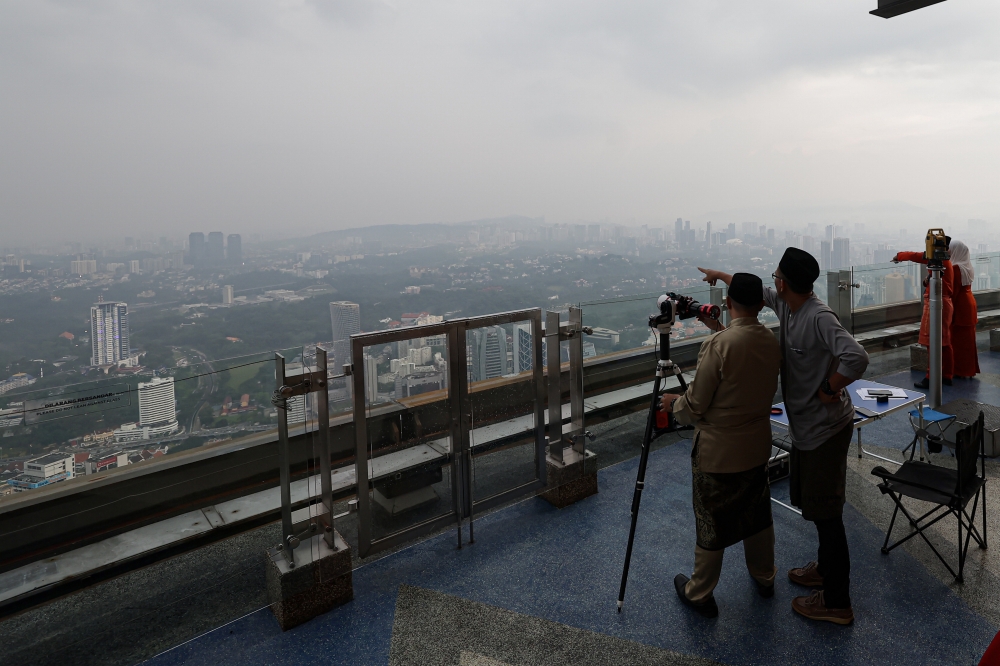High above KL, a watchful wait: The experience of spotting the new moon for Hari Raya

KUALA LUMPUR, March 30 — High above the city at KL Tower, officials from the Federal Territory Mufti’s Office stood ready, their eyes fixed on the horizon, awaiting the sliver of light that would determine the end of Ramadan.
The task before them was as old as Islam itself: spotting the new moon, or anak bulan, which would decide whether Malaysians would celebrate Hari Raya Aidilfitri on Monday or fast for one more day.
Earlier in the evening, rain had fallen steadily from 5pm before easing about an hour later, leaving behind a cloudy sky tinged with haze, which added to the challenge of the sighting.
The evening’s proceedings began with a solemn recitation of Surah Yasin, followed by prayers joined by all attendees — a customary practice during moon sightings for Ramadan, Syawal, and Zulhijjah.
Following this, Federal Territories Mufti, Datuk Luqman Abdullah, addressed the gathering with a brief speech, offering a reminder of the process ahead.
“We’ll be up there for 49 minutes, until 8.15pm. That’s long,” he quipped, drawing a few quiet chuckles from the group.
An officer then gave a technical briefing on the positions of the moon and sun, setting the stage for the meticulous observations to come.
“Our job here is to sight the new moon, which can signify a new month,” he explained.
The officer also explained the process of sighting a new moon and its criteria.
At around 7pm, the attendees, including members of the moon sighting committee, were ushered to the observation deck at TH05, the sky deck level of KL Tower.
Four technical instruments — the theodolite, telescope, and binoculars — were set up, all aimed at the fading light on the horizon, awaiting the faintest hint of the crescent moon.
As the golden hues of sunset painted the Kuala Lumpur skyline, the team, dressed in traditional Baju Melayu and songkok, worked with quiet precision.
With years of experience, they knew exactly where to look, their gazes sharpened by practice and aided by high-powered telescopes.
The organisers had prepared dates, traditional kuih, and small bottles of mineral wter for Muslims to break their fast — a simple yet thoughtful gesture as they carried out their sacred duty.

“We’ll look at the moon first. After Maghrib, we will know the result and inform the Keeper of the Rulers’ Seal. He will then seek the consent of His Majesty before making the announcement,” said an officer who wished to remain anonymous.
Officers took shifts scanning the sky, while some went downstairs to perform their Maghrib prayers before returning to resume their watch.
Despite modern advancements in astronomy, Malaysia continues to rely on both rukyah (sighting) and hisab (calculations) to determine the Islamic calendar, keeping the role of these observers crucial, a mix of science and faith guiding their efforts.
As the sky darkened, anticipation grew. Some peered through their telescopes, others whispered about other sighting locations, cross-checking against own projections and waiting for confirmation.
If the moon was sighted, the news would be relayed to the Keeper of the Rulers’ Seal, who would then announce the decision to the nation.
However, as the minutes passed, the outcome became clear.
“The Mufti has already informed the Keeper of the Rulers’ Seal. We can’t see the moon here tonight, but there are reports of sightings in Terengganu, Sabah, Sarawak, and Labuan,” an officer told Malay Mail.
“Our job here is to see the moon. Only the Keeper of the Rulers’ Seal can announce if it’s Raya tomorrow or the day after,” he added.
And so, as the city lights flickered on below, the final decision awaited its official proclamation, an ancient tradition carried out yet again, high above Kuala Lumpur.

